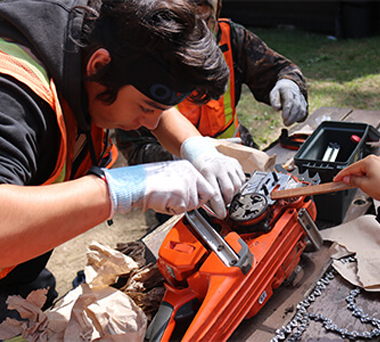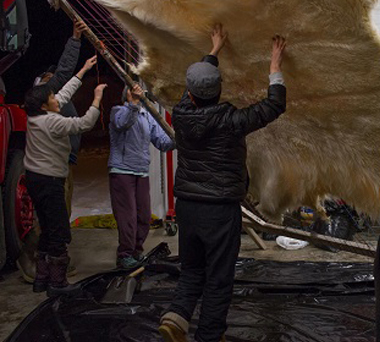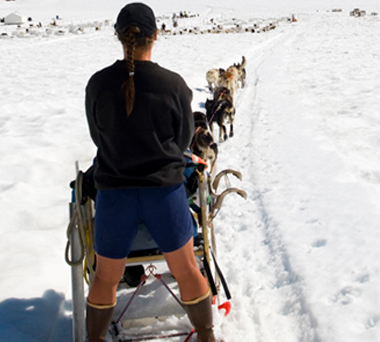
Research
As part of our commitment to the Future Skills Centre, the Conference Board will research the skills Canadians are going to need and deliver insights on labour markets and learning ecosystems.
Our work focuses on the skills people need to make their livings and the paths they need to take to get there. We look at the impact of automation, sustainable livelihoods, career pathways, in-demand skills, and take a skills perspective on labour market information.
As well, we examine the role of post-secondary education and how skills are developed through work-integrated and experiential learning and apprenticeships to better understand how to prepare for the future.
124
Publication outputs
Latest Releases

Building a Stronger Skills Development Landscape in Nunavut, Northern Ontario, and Yukon
Indigenous & Northern Communities October 21, 2024
Communities in the Northern regions of Canada continue to undergo significant transformation. Conference Board forecasts show that real GDP in Yukon, Nunavut, and Northern Ontario is expected to grow by 41 per cent, 8 per cent, and 20 per cent, respectively, between 2024 and 2045. Employment is also expected to increase by 10 per cent in Yukon, 18 per cent in Nunavut, and 5 per cent in Northern Ontario during the same time time frame. In this period of change, there is a high demand for skilled workers.
Impact paper • 43-min read

Economic and Labour Forecast for Northern Ontario, Yukon, and Nunavut
Indigenous & Northern Communities October 21, 2024
We expect real gross domestic product (GDP) growth to be strong in Northern Ontario and Yukon, with slower growth predicted for Nunavut. Conversely, we expect Nunavut to experience the largest per cent increase in employment. Over the forecast period, we expect employment to increase by 5 per cent in Northern Ontario, 18 per cent in Nunavut, and 10 per cent in Yukon.
Online experience • 8-min read

How Are Educators Navigating the AI Revolution?
Education & Skills October 10, 2024
With increasingly powerful generative artificial intelligence (AI) tools available to students, post-secondary institutions (PSIs) have been playing catch-up to adapt to a new reality. In June 2023, six months after the release of ChatGPT, less than half of the world’s top 50 universities (ranked by Times Higher Education) had publicly available guidelines addressing generative AI.
Data briefing • 8-min read
Research by Theme
Canadians with disabilities have the potential to be highly engaged and productive employees, but many face barriers in accessing employment and often do not receive the supports and accommodations they need to facilitate their access to leadership-track positions. Our work examines how to better support workers living with both visible and non-visible disabilities by creating diverse and inclusive work environments.
From Campus to Career
Education & Skills June 3, 2024
International students are an integral part of Canada’s labour force, now and into the future. But after graduation they have poorer economic outcomes than Canadian-born students. What’s needed to improve international students’ study-to-work transitions?
Online experience • 8-min read
Opportunity for All: Improving Workplace Experiences and Career Outcomes for Canadians With Disabilities
Education & Skills, Inclusion September 11, 2023
People with disabilities often face barriers to employment and career progression. Only 59 per cent of Canadians with disabilities reported being employed in 2017, compared with 80 per cent of Canadians without disabilities.
Issue briefing • 18-min read
Building Neuroinclusive Workplaces
Inclusion March 28, 2023
There are many benefits to creating a neuroinclusive workspace. Yet neurodivergent Canadians continue to face barriers to employment and career progression. With many Canadian companies experiencing significant labour shortages, employers can benefit from recruiting and supporting talent from underrepresented groups, including neurodivergent workers.
Summary for executives • 2-min read
Breaking Down Barriers: Improving the Workplace Experience for Neurodivergent Canadians
Inclusion March 14, 2023
Canadian companies have a lot to gain from embracing neurodiversity in the workplace. Yet neurodivergent Canadians continue to face barriers to employment and career progression.
Impact paper • 45-min read
Building Workplaces Where Neurodivergent Workers Thrive
Inclusion November 10, 2022
Neurodivergent individuals experience barriers in accessing employment and often lack the supports and accommodations that facilitate career progression and access to leadership-track positions. These barriers stem from an undervaluing of neurodivergent workers’ strengths in the workplace, as well as biases against the way that neurodivergent individuals may present themselves and/or communicate with others during the interview process or within the work environment.
Issue briefing • 9-min read

Modelling Job Transitions in Canada
Education & Skills March 16, 2021
Employment in Canada is going to look different in the future. The types of education, abilities, skills, and experiences that employers seek are evolving amid a confluence of forces reshaping the nature of work around the world. Disruptive technologies like artificial intelligence and robotics, unmanned vehicles, and the Internet of Things, the growing share of knowledge-based services, and the rise of technology-enabled platforms will reshape careers.
Primer • 20-min read
A revolution is coming to the skilled trades, and tradespeople will need a range of new digital skills to keep pace with the future of work. Our research explores the future of work in skilled trades and the role that apprenticeships can play in preparing for an increasingly dynamic workforce. Focusing on several sectors undergoing change, our research lays the groundwork for additional work in experiential learning.

Rising Skills: A Toolbox Talk on Social and Emotional Skills in the Construction Trades
Education & Skills December 14, 2021
The construction trades workforce is changing. Tradespeople are tackling new challenges in multi-generational and increasingly diverse workplaces. What skills do tradespeople need to adapt to these trends?
Issue briefing • 15-min read

Rising Skills: Digital Skills Needs for Smart and Connected Vehicles
Education & Skills December 14, 2020
As the automotive industry shifts toward connected, autonomous, shared, and electric (CASE) vehicles, tradespeople will need stronger digital competencies. To work with new tools on smart vehicles, tradespeople need seven core digital skills.
Issue briefing • 15-min read

Rising Skills: Digital Upskilling for Advanced Manufacturing Workplaces
Education & Skills December 14, 2020
The manufacturing sector is becoming more technologically advanced. Tradespeople need 21st-century digital skills to adapt to these 21st-century workplaces. But the sector is struggling to attract young people and women into the trades..
Summary for executives • 4-min read

Rising Skills: Emerging Skills in the Food Services Trades
Education & Skills December 14, 2020
Commercial kitchens are becoming more automated, connected, and diverse workplaces. Repetitive tasks are being automated, freeing up time for workers. Food‑delivery apps and the increasing use of social media are changing the way customers and restaurants interact. And labour shortages mean employers need to work harder to find the skilled talent they need, especially Red Seal‑certified cooks.
Issue briefing • 20-min read

Bridging Generational Divides: Advancing Digital Skills in Canada’s Apprenticeships and Skilled Trades Ecosystem
Education & Skills September 15, 2020
Tradespeople will need a range of new digital skills to keep pace with the future of work. These are the technical and non-technical skills needed to thrive in digitally connected workplaces. The next generation of tradespeople will need them to operate computerized equipment, access blueprints on digital devices, and use digital diagnostic tools, among other tasks.
Impact paper • 30-min read

Bridging Generational Divides: Digital Skills in the Trades
Education & Skills September 15, 2020
Tradespeople identified seven core 21st-century digital skills that are needed to adapt to the future of the trades. These skills require knowledge of digital tools and interact with both trade-specific technical knowledge and social/emotional skills, which evolve over a person’s lifespan.
Summary for executives • 4-min read

There’s a Revolution Happening in Skilled Trades
Education & Skills April 8, 2020
The revolution is being sparked by automation, low-carbon economies, digitization, and other emerging work trends. These new technologies need skills that are not usually at the core of a trade school education.
Online experience • 8-min read
Building on our previous research on occupations at-risk from automation, this work examines the pathways people might take to transition to more stable careers. Starting with the growing occupations in the clean economy, we look at skills, jobs, and training data to identify occupations that will become important. We examine the human factors in job transitions, and start to clear a path from at-risk to rapid growth.
Digital Occupation Pathways: From Vulnerable Jobs to Rapid-Growth Careers
Education & Skills March 29, 2023
Advances in digital and automation technologies are fundamentally changing how goods and services are produced and delivered and will have huge implications for the labour market. While investment in technology and the resulting productivity gains are a desired outcome for the economy, it creates uncertainty for workers whose skills become obsolete in this process.
Impact paper • 65-min read

Transitioning to Jobs in the Clean Economy
Innovation & Technology July 28, 2022
One in five Canadian employees works at a job that’s vulnerable to automation. The clean economy is a rapid-growth sector that needs workers. Is there a way to solve for both? Employees working high-risk, low-mobility (HRLM) jobs have few options to transition into lower-risk occupations without undergoing retraining.
Online experience • 8-min read

Responding to Automation: Building a Cleaner Future
Innovation & Technology June 3, 2021
Could the clean economy offer brighter futures for workers at risk of automation? In a previous study, we identified 92 occupations at a high risk of automation with few desirable opportunities to transition into lower-risk ones. These high-risk, low-mobility (HRLM) occupations account for one in five employees in Canada. Is your industry vulnerable to automation?
Online experience • 8-min read
We examine the major factors that shape career pathways for Indigenous finance and management professionals and identify resources that have helped Indigenous professionals establish their careers. This work seeks to understand what’s needed to grow the talent pool of Indigenous corporate services professionals.
Indigenous Youth in Finance
Indigenous & Northern Communities September 23, 2024
Indigenous youth are a rapidly growing force in the Canadian labour market, with a wave of 459,215 First Nations, Inuit, and Métis under the age of 14 soon to join the labour market. Tapping into this young cohort and helping them to choose careers in finance and management could be a win–win–win situation for the youth, organizations, and communities.
Issue briefing • 27-min read

Indigenous Finance and Management Professionals
Indigenous & Northern Communities June 22, 2022
As reflected in recent Supreme Court decisions, parliamentary debates, and public opinion polls, Indigenous rights are increasingly part of major project decisions. This spans sectors such as power generation, mining, and oil and gas. While at times contentious, the assertion of Indigenous rights presents a bold new vision of economic reconciliation with opportunities for Indigenous communities looking to determine their economic futures.
Impact paper • 29-min read

Finance and Management Skills for Economic Reconciliation
Indigenous & Northern Communities April 27, 2022
To shape Canada’s economy in partnership with Indigenous people, we need to understand how a dynamic new generation of Indigenous professionals can take the lead in managing their communities’ unique corporate services. Indigenous skilled labour is critical to realizing a new vision of economic reconciliation where First Nations, Métis, and Inuit communities control their economic futures.
Online experience • 8-min read

Indigenous Financial Management: Finally Finding Balance
Indigenous & Northern Communities June 4, 2020
To shape Canada’s future economy and build Indigenous communities across the country, we need more Indigenous people in finance and management roles in both Indigenous and non-Indigenous organizations.
Online experience • 4-min read
There are many forms of Indigenous-centred post-secondary education in Canada trying to help Indigenous students do well in school. Our work identifies the best practices that leading Indigenous institutes have developed to help First Nation, Métis, and Inuit students succeed in post-secondary fields and the job market. It also explores how Indigenous institutes compare with, and complement, public post-secondary institutions.

Filling in the Map of Indigenous Controlled Post-Secondary Education in Canada
Indigenous & Northern Communities March 17, 2021
Many Indigenous groups across Canada mandate, govern, and control their own post-secondary institutions. These Indigenous Institutes support lifelong learning as defined by Indigenous Peoples. They also offer education grounded in Indigenous languages, pedagogies, cultures, and worldviews.
Online experience • 17-min read

Opportunities for Collaboration in Indigenous Education
Indigenous & Northern Communities December 7, 2020
Indigenous Institutes play an essential role in helping Indigenous peoples—Canada’s fastest-growing population prepare for the labour market. And they bring a distinctly Indigenous lens to higher education. Many are looking for ways to support Indigenous learners and provide culturally safe spaces for learning and research.
Online experience • 8-min read

Old School/New School: Comparing Indigenous-Centred Post-Secondary Education in Canada
Indigenous & Northern Communities March 26, 2020
In 1972 the Assembly of First Nations—launched a movement by First Nations to reclaim control of their education. Fifty years on, many forms of Indigenous-centred post-secondary education (PSE) exist in Canada. All of them aspire to help Indigenous students succeed.
Online experience • 8-min read
Can cross-cultural curricula help Indigenous learners transition to, and graduate from, post-secondary STEM fields? And will they open doors to employment opportunities? Our research identifies best practices for designing, teaching, and supporting cross-cultural STEM curricula for First Nation, Métis, and Inuit students. It also looks at how sectoral change is affecting employment in STEM fields and the skills development ecosystems that serve Indigenous learners—and what can be done to seize emerging opportunities.

Saskatchewan’s Forest Sector: Future Skills for an Indigenous-Led Revitalization
Indigenous & Northern Communities November 30, 2021
The Canadian forest sector is facing a challenge to attract, train, and retain workers. In this boom-and-bust industry, forestry companies must increase efficiency in order to remain competitive when the market is weak while also responding to growing demand for sustainable practices and high-value wood products. Indigenous forestry businesses are no strangers to this dilemma.
Case study • 25-min read

Skills Development in Northern Mining Regions
Indigenous & Northern Communities November 4, 2021
For many northern Indigenous communities, mineral exploration properties and active mines are the closest employers. Mining is big business in northern Manitoba. The industry has been a strong source of employment for Indigenous workers, with accessible entry-level positions and opportunities to learn on the job. While the benefits of short-term job training are attractive, Indigenous communities are having to make complicated decisions about economic development that have long-term implications.
Case study • 15-min read

Skills Development in the North: An Ecosystem Shaped by Distinct Challenges
Indigenous & Northern Communities September 9, 2021
Occupations and in-demand skills are changing. Two-thirds of workers expect their jobs to be changed by technology every five years. Other forces driving labour market change in Northern Canada include commodity cycles, demographic change, climate change, modern treaties, and Indigenous self-government. Understanding how these changes impact workforce development across Northern Canada requires looking beyond the training institutions that deliver skills for jobs.
Primer • 30-min read

Technological Change in the North
Indigenous & Northern Communities May 20, 2021
The economy in Northern Canada is changing. Sectors, such as mining, forestry, and tourism, can quickly expand or contract. Advancing technology is one factor driving those changes. As technologies change, jobs and occupations evolve. Skills development must keep pace if workers are to seize future employment opportunities in the North.
Online experience • 8-min read

Learning Together: STEM Outreach Programs for Indigenous Students
Indigenous & Northern Communities December 9, 2020
In response to a national conversation about reconciliation, governments, the formal education system, and non-profit organizations are wanting to address educational gaps and improve the representation of Indigenous peoples in STEM with extra attention and resources. This awareness, combined with an increasing focus on equity issues in STEM, has increased efforts to bring STEM outreach to Indigenous students.
Impact paper • 25-min read

Indigenous STEM Access Programs: Leading Post-Secondary Inclusion
Indigenous & Northern Communities December 9, 2020
The transition from high school to post-secondary education (PSE) is a time of uncertainty for many students. Educational, cultural, and economic challenges make this transition even more complex for Indigenous learners transferring into PSE in science, technology, engineering, and mathematics.
Issue briefing • 14-min read

Curriculum and Reconciliation: Introducing Indigenous Perspectives into K–12 Science
Indigenous & Northern Communities October 15, 2020
The Indigenous population in Canada is younger and growing more rapidly than any other socio-demographic segment in the country. Expanding resource development opportunities and increasing recognition of Indigenous rights are creating unique economic opportunities for Indigenous peoples.
Impact paper • 32-min read

Incorporating Indigenous Cultures and Realities in STEM
Indigenous & Northern Communities June 11, 2020
When educators use a culturally responsive curriculum—one that bridges Indigenous ways of knowing with Western science—Indigenous students are more engaged and perform better.
Primer • 40-min read

How Can More Indigenous People Access STEM Careers?
Indigenous & Northern Communities March 26, 2020
About 4 per cent of Canadian adults are Indigenous. But less than 2 per cent of people working in science, technology, engineering, and math (STEM) occupations are. Improving Indigenous participation and leadership in major economic sectors, such as science, technology, and finance, is an important part of the reconciliation journey.
Online experience • 8-min read
Automation-enabling technologies will cause swift changes in the skills many industries need. In our work, we identify which employees are at high risk from automation and have limited ability to transition into new roles. We also examine where these jobs are concentrated—both in terms of industries and regions—and which technologies are most likely to disrupt labour markets.
The Next Frontier in Canada’s Agri-Food Sector
Innovation & Technology July 31, 2024
The sector benefits from abundant land and water resources and a strong global reputation as a trusted supplier of safe, high-quality food. These factors have the potential to make Canada a leader in sustainable food production and processing. However, taking advantage of these opportunities and leveraging the country’s strengths depends on the sector’s ability to adapt to technological change and access a qualified labour force.
Impact paper • 25-min read

Automation Vulnerability in Canada
Innovation & Technology April 15, 2021
The Automation Vulnerability Index (AVI) measures how susceptible a region is to disruption by automation. It ranges from 0 to 1, with higher index scores indicating more vulnerability. The Index comprises five indicators with equal weights.
Online experience • 8-min read

Automation in Canada’s Regions
Innovation & Technology April 8, 2021
Our leaders need to be ready. Automation-enabling technologies such as artificial intelligence and robotics will cause swift changes in the skills many industries need. In Canada, nearly one in five employees are already in an occupation at high risk of automation, where transitioning into a lower-risk occupation would require significant retraining.
Online experience • 8-min read

Preparing Canada’s Economies for Automation
Innovation & Technology March 15, 2021
Employment declines in occupations that involve routine tasks have been under way for decades. However, it is unclear how advances in artificial intelligence (AI) and robotics will impact local economies. As some occupations and industries are more vulnerable to automation than others, and regional economies have different occupational and industry mixes, regions may experience the impact of automation differently.
Issue briefing • 15-min read

Responding to Automation: Technology Adoption in Canadian Industries
Innovation & Technology January 28, 2021
Canadian industries have experienced rapid technological change with the advent of several transformative innovations over the past decade. Different technologies pose different re-skilling and occupational transition challenges across industries. Business leaders need to be mindful of which technology they adopt.
Impact paper • 20-min read

Bracing for Automation: What Are Canada’s Most Vulnerable Jobs?
Innovation & Technology May 28, 2020
In an era of lightning-fast technological change, it’s more important than ever that Canadian leaders understand how the adoption of new technologies will impact Canada’s labour force..
Online experience • 8-min read
Our novel research applies a skills framework based on international sources and job postings data to Canadian labour data. This will allow us to identify skill vacancies and provide longer-term supply and demand forecasts of skills under different assumptions. It will also help us understand how skills cluster together, how skills are developed, how the market values skills, and to identify viable and desirable career transitions for workers.
Which Skills Shortages Are Impacting Canadian Productivity?
Canadian Economics August 15, 2024
Canada has a productivity problem. Labour productivity growth—the amount of output produced per hour worked—has stalled. The Canadian economy’s labour productivity at the end of 2023 was around the same as it was in 2017. This is the second time that Canada’s productivity growth has been notably weaker than the United States’ in recent decades, with the first occurring between 2003 and 2012.
Impact paper • 25-min read
Navigating the Transition
Education & Skills October 10, 2023
Canada’s insurance industry is poised for significant growth in the coming years, even with the abundance of job vacancies already existing. This additional growth will create even more demand for skilled professionals to fill numerous job opportunities.
Issue briefing • 12-min read
Valuing Skills in Canada: A Statistical Approach
Education & Skills May 23, 2023
A key ingredient for a successful and financially rewarding career is having useful and valuable skills that enable people to perform specific jobs. Accordingly, we expect workers with in-demand skills to earn higher wages and salaries, reflecting the need for those skills in the workplace.
Impact paper • 33-min read
Working Together for a Sustainable Future
Education & Skills March 3, 2023
To avert the worst impacts of climate change, Canada has set an ambitious goal of achieving net-zero GHG emissions by 2050. Transitioning to a net-zero economy is expected to be disruptive, but it will also create new global employment opportunities.
Online experience • 8-min read

The Model of Occupations, Skills and Technology
Canadian Economics October 11, 2022
To help prepare Canadians for the future of work, our researchers and data scientists proudly developed the MOST on behalf of the Future Skills Centre. A sophisticated and data-rich projection tool, the MOST is designed to offer unique insights into the skills that will power Canada’s future labour markets.
Online experience • 8-min read

Beyond Blue and White Collar: A Skills-Based Approach to Canadian Job Groupings
Canadian Economics August 3, 2022
In Canada’s modern, knowledge-based, and service-centric economy, employers are increasingly thinking about work from a skills perspective. Old-fashioned labels like “blue collar” and “white collar” are no longer relevant. As well, factors such as educational attainment or work experience are only proxies for assessing the skills of workers. This means that we need a more sophisticated way to talk about employment opportunities.
Issue briefing • 10-min read

Future Skills Summit 2022: Insights Summary
Education & Skills June 14, 2022
In February 2022, The Conference Board of Canada presented the Future Skills Centre’s first national summit. The virtual summit hosted more than 1,700 participants and 55 speakers. It included plenaries, fireside chats, panel discussions, and ActionLabs that profiled key learnings from ongoing Future Skills Centre projects. Here, we summarize the learnings from the summit.
Issue briefing • 19-min read

Career Able: Job Transitions for Canadians With Disabilities
Inclusion May 16, 2022
Everyone needs career options, including people with disabilities. The Conference Board of Canada, on behalf of the Future Skills Centre, is leading a study to support the job transitions of people with disabilities. The study aims to promote labour market retention and career mobility for this equity-deserving group.
Online experience • 8-min read

Economic Cost of Skills Vacancies
Canadian Economics March 2, 2022
When an employer wants to fill a vacant job, they are really looking for a set of skills to help them complete specific tasks. Until that employer can recruit a new employee, they don’t have access to the skills they need. So job vacancies can actually be thought of as skill-set vacancies: an unmet need for particular skills.
Online experience • 8-min read

Space to Grow: Job Transitions in Ontario’s Tourism and Hospitality Industry
Canadian Economics April 23, 2021
Tourism and hospitality is one of Ontario’s key economic drivers. In 2019, the sector employed over 620,000 Ontarians and generated nearly $21 billion in labour income. Before the pandemic-related disruptions, employment in the sector had been stable and sustainable. However, Ontario’s labour market is steadily evolving and, for some tourism and hospitality workers, this evolution has led to job losses, and the COVID-19 pandemic has increased and accelerated these pressures.
Impact paper • 15-min read
OpportuNext: Online Career Transition Tool
Education & Skills April 8, 2021
A new solution for a changing job market. Switching careers can be hard—but what if there were an easier way to identify, assess and pursue new opportunities? The Conference Board of Canada and the Future Skills Centre are excited to launch a free online tool designed to help job placement professionals, jobseekers and employers quickly and easily explore viable career transition pathways.
Online experience • 8-min read

A Path Forward Job Transitions in Canada
Education & Skills March 16, 2021
Workers considering a career change need to better understand how to capitalize on their current skills, education, abilities, experience, and knowledge. Similarly, human resource professionals, educational institutions, and labour market policy-makers need a better sense of what skills, education, abilities, experience, and knowledge characteristics make someone more employable, today and in the future.
Impact paper • 25-min read

Bridging Canada’s Skills Gap
Canadian Economics March 24, 2021
The skills that workers need are changing thanks to automation and new technologies. That means it’s more important than ever to find reliable ways to identify the gaps between the skills workers have and the skills employers need, and how those gaps will change over time.
Online experience • 8-min read
Identifying the skills that will be needed for tomorrow’s world of work.

Regional and Virtual Sounding Tours
Education & Skills March 14, 2022
In collaboration with the Future Skills Centre (FSC), The Conference Board of Canada engaged Canadians who are actively engaged in the country’s skills and training community, as well as individuals interested in learning more about skills development and the future of work.
Online experience • 8-min read
The most in-demand job skills aren’t technical—they’re social and emotional. These include skills like communication, leadership, cultural competence, resiliency, and problem-solving. Our research in this area explores several aspects of social and emotional skills—how they are perceived and valued in the workplace, how they are measured, and their potential to help workers transition between jobs.
Building a Stronger Skills Development Landscape in Nunavut, Northern Ontario, and Yukon
Indigenous & Northern Communities October 21, 2024
Communities in the Northern regions of Canada continue to undergo significant transformation. Conference Board forecasts show that real GDP in Yukon, Nunavut, and Northern Ontario is expected to grow by 41 per cent, 8 per cent, and 20 per cent, respectively, between 2024 and 2045. Employment is also expected to increase by 10 per cent in Yukon, 18 per cent in Nunavut, and 5 per cent in Northern Ontario during the same time time frame. In this period of change, there is a high demand for skilled workers.
Impact paper • 43-min read
Economic and Labour Forecast for Northern Ontario, Yukon, and Nunavut
Indigenous & Northern Communities October 21, 2024
We expect real gross domestic product (GDP) growth to be strong in Northern Ontario and Yukon, with slower growth predicted for Nunavut. Conversely, we expect Nunavut to experience the largest per cent increase in employment. Over the forecast period, we expect employment to increase by 5 per cent in Northern Ontario, 18 per cent in Nunavut, and 10 per cent in Yukon.
Online experience • 8-min read
How Are Educators Navigating the AI Revolution?
Education & Skills October 10, 2024
With increasingly powerful generative artificial intelligence (AI) tools available to students, post-secondary institutions (PSIs) have been playing catch-up to adapt to a new reality. In June 2023, six months after the release of ChatGPT, less than half of the world’s top 50 universities (ranked by Times Higher Education) had publicly available guidelines addressing generative AI.
Data briefing • 8-min read
What Actions Are Post-secondary Institutions Taking?
Education & Skills August 14, 2024
The federal government has committed to having the country achieve net-zero emissions by 2050. Post-secondary institutions (PSIs) play a key role in helping Canada reach this goal because they equip students with the skills and know-how needed to transition to a more sustainable economy. These multi-faceted competencies are broadly considered to be green skills.
Issue briefing • 10-min read
Diabetic Foot Care and Lower Limb Preservation
Health July 18, 2024
Diabetic foot ulcers impact patients’ mobility, employment and quality of life. They frequently become infected and, if not appropriately managed in a timely manner, can result in amputation. Lower extremity amputations have life-changing physical, mental wellness, and economic impacts.
Issue briefing • 17-min read
Strengthening Interprofessional Collaboration in Diabetic Foot Care
Health July 18, 2024
Canadians at risk of developing diabetic foot ulcers currently need to navigate complex pathways to find effective, affordable, timely, and culturally responsive care. There is often limited communication and coordination between their healthcare practitioners, and a lack of continuity between different sectors of the health and care ecosystem.
Issue briefing • 8-min read
Who Is Using Generative AI in Higher Education?
Education & Skills July 8, 2024
While institutions scramble to craft policies for generative AI use, one in five students report using it most or all of the time, and 35 per cent report using it some of the time. But how does the uptake of generative AI vary across social groups in the student population?
Data briefing • 10-min read
The Heart of the Matter: Understanding Hiring Demand for Social and Emotional Skills
Education & Skills June 13, 2024
Social and emotional skills (SES) play a vital role in navigating the complexities of the modern workplace. As artificial intelligence (AI) continues to reshape industries and automate routine tasks, employers are recognizing the significance of fostering SES in the workforce.
Data briefing • 15-min read
SES in the Workplace: Insights From Canadian Employers
Education & Skills June 13, 2024
We asked employers about the kinds of SES they want in new hires, how they assess SES during hiring, and the challenges they face when recruiting for and evaluating these skills.
Issue briefing • 13-min read
Employers’ Insights on Social and Emotional Skills
Education & Skills June 13, 2024
Social and emotional skills (SES)—also called soft, human, or people skills—are increasingly important for the future of work. What types of SES are employers looking for? How do they assess these skills? What challenges are employers facing recruiting employees with strong SES.
Summary for executives • 3-min read
An Analysis of the Demand for Green Skills in Canada
Education & Skills June 6, 2024
The threat of climate change is driving an urgent need to decrease reliance on unsustainable practices and technologies in the workplace. The transition to the green economy is expected to create new employment opportunities and surging demand for green expertise for the sustainable jobs of today and tomorrow.
Data briefing • 10-min read
Situating Neurodiversity in Post-Secondary Education
Education & Skills May 30, 2024
Canadian post-secondary institutions (PSIs) have a responsibility to provide inclusive opportunities for all learners. But they don’t yet have the knowledge and evidence-based strategies needed to address the current challenges neurodiverse students face.
Online experience • 3-min read
AI and the Future of Post-Secondary Education: Navigating the AI Revolution
Education & Skills January 4, 2024
Despite the many potential benefits of generative AI for teaching and learning, there are also concerns around academic integrity, accuracy, reliability, privacy, and data security. But generative AI is here to stay. Are Canadian post-secondary institutions ready?
Online experience • 8-min read
Levelling the Playing Field for Black Canadians
Education & Skills November 16, 2023
Black Canadians perceive that employers undervalue their skills and knowledge. Not valuing people’s skills, and feeling that your skills are not recognized, can create barriers to inclusive workplaces, which ultimately holds Black employees back.
Impact paper • 30-min read
Building a Resilient Workforce: Meeting Employer Demand for Social and Emotional Skills in the 21st Century
Education & Skills October 24, 2023
The Conference Board of Canada, on behalf of the Future Skills Centre, is exploring how Canadian employers identify and assess social and emotional skills (SES) in new and potential employees.
Online experience • 17-min read
Toward a More Sustainable Future
Education & Skills August 3, 2023
The Conference Board of Canada, on behalf of the Future Skills Centre, is studying how Canadian post-secondary institutions (PSIs) are preparing future graduates with the green skills that are needed for a more sustainable future.
Online experience • 8-min read
Can Social and Emotional Skills Be Taught? An Analysis of Adult Training Programs
Education & Skills July 12, 2023
Post-secondary institutions have an important role in developing social and emotional skills (SES). SES include skills such as active listening, empathy, communication, collaboration, and resilience. These skills are in high demand by employers, despite the ongoing digitization in workplaces.
Issue briefing • 20-min read
Building a Digitally Skilled Workforce
Education & Skills March 7, 2023
When it comes to digital skills, Canada is falling behind. How can we ensure that Canadian employers have the skills they need to adapt, innovate, and grow in an increasingly digital future?
Impact paper • 15-min read
Digital Skills for Today and Tomorrow
Education & Skills September 27, 2022
The pandemic changed how many Canadian workers do their job. For some, this change is minor. For others, it is seismic. A central feature of the shifts in working is the increased interaction with, and reliance on, digital tools. These tools—and the skills needed to use them—are largely what helped Canada weather the economic storm the pandemic caused and continue to support Canadian businesses in a strong recovery.
Issue briefing • 12-min read

Finding Your Employability Skills
Education & Skills July 28, 2022
The Employability Skills Toolkit is a guide to the skills needed to adapt and succeed in the world of work. It includes explanations and descriptions of these skills and ways to build them. The Toolkit includes key information about how to become job-ready and exercises to practice and apply what you have learned.
Online experience • 8-min read

Digital Skills for a Future-Ready World
Education & Skills May 11, 2022
Our world has become more and more digital in recent decades. Prior to the pandemic, the pace of digitalization was consistently increasing with the non-stop introduction of new digital tools and technologies. The pandemic hit, and that pace accelerated even more.
Online experience • 8-min read

Strengthening Social and Emotional Skills in Adults: The Learning Experience at Canadian Colleges
Education & Skills April 13, 2022
We know that social and emotional skills (SES)—such as communication, collaboration, and leadership—are critical for life success. Yet the bulk of programs that teach SES end after high school. We continue developing SES in adulthood—through informal experiences like employment, co-ops, volunteering, extracurriculars, and caregiving, as well as formal instruction. These skills are important. So how are post-secondary institutions teaching them?
Online experience • 8-min read

Bridging the Gap Between Identity and Social and Emotional Skills
Education & Skills April 13, 2022
According to previous work by The Conference Board of Canada, the changing nature of work is increasing the demand not only for technical skills, but also for social and emotional skills (SES). SES are associated with employability and include skills like leadership, cultural competence, active listening, problem-solving, resiliency, collaboration, and communication.
Issue briefing • 9-min read

Finding Value: Identifying and Assessing Social and Emotional Skills in the Tourism and Hospitality Industry
Education & Skills September 21, 2021
The COVID-19 pandemic has negatively impacted the tourism and hospitality (T&H) sector, leading to business closures and employee layoffs. Traditionally, the T&H sector attracts young Canadians with little to no work experience. Yet young T&H workers who have no work experience outside of the sector have been severely impacted by layoffs.
Impact paper • 15-min read

Searching for Strengths: Gaps and Opportunities for Social and Emotional Skills Development in the Tourism and Hospitality Sector
Education & Skills September 21, 2021
The tourism and hospitality sector was hit especially hard by the pandemic. The International Monetary Fund reported that the industry “will continue to struggle until people feel safe to travel en masse again.” Helping displaced workers in the sector find new and meaningful employment is crucial to both the people who have been directly affected and the broader economic recovery.
Issue briefing • 15-min read

Social and Emotional Skills Are Top of Mind Across Canada
Education & Skills January 25, 2021
When we asked people across Canada to identify the most important skills for career success, they overwhelmingly identified social and emotional skills (SES), like communication, critical thinking, and interpersonal skills, along with leadership and adaptability.
Summary for executives • 4-min read

What Are Canadian Post-Secondary Institutions Saying and Doing?
Education & Skills January 21, 2021
Beyond what institutions are saying, we also wanted to understand what they are doing to develop student social and emotional skills (SES). Post-secondary activities that promote SES development fall into two categories: extra-curricular or embedded within programs and curricula. We scanned PSI program and departmental websites to find examples from across Canada.
Issue briefing • 15-min read
Measuring Social and Emotional Skills
Education & Skills November 10, 2020
The demand for social and emotional skills (SES) is growing. But few reliable tools are available to measure SES in adolescents and adults, and it can be difficult to figure out which existing tools are best. Also, there’s little consensus among researchers and practitioners on how to best define and measure SES.
Online experience • 8-min read

The Future is Social and Emotional: Summary for Executives
Education & Skills April 29, 2020
More and more, employers require new hires who possess not only specialized knowledge and technical skills, but also social and emotional or “human” skills.
Summary for executives • 4-min read

The Future Is Social and Emotional: Evolving Skills Needs in the 21st Century
Education & Skills April 8, 2020
Demand for skilled employees is not new, but the skills considered “in demand” have evolved. While developing skills is a life long endeavour, the skills that Canadians learn through post-secondary training are key to workplace success. But demand for social and emotional skills (SES) is growing. Are we doing enough to prepare Canadians for the evolving workplace?
Online experience • 8-min read

The Future Is Social and Emotional: Evolving Skills Needs in the 21st Century
Education & Skills April 8, 2020
The most in-demand skills for today’s and tomorrow’s labour market aren’t technical—they’re social and emotional. Academic research and industry surveys on skills needs indicate that social and emotional skills (SES), or human skills, are critical for employability and career success. But are Canada’s education and training systems doing enough to prepare students for work?
Impact paper • 38-min read
This work examines career pathways for Indigenous workers in Inuit Nunangat and how Inuit skills, knowledge, and values can be applied to market-based employment opportunities. To help understand the context, we identified factors that create non-standard employment conditions for Inuit labour in Northern Canada. Our work also describes and analyzes resources that have helped Northern Inuit workers establish their careers.
Approaches for Skills Inclusion in Inuit Nunangat
Indigenous & Northern Communities June 20, 2023
This toolkit will help employers with recruitment and retention in Inuit Nunangat through meaningful inclusion practices, policies that accommodate traditional practices and community responsibilities, and clear career paths.
Online experience • 30-min read
Building Bridges: Increasing Opportunity for Inuit
Indigenous & Northern Communities April 17, 2023
Hunters play an important role in the mixed economy of Inuit Nunangat, the Inuit homeland across the Arctic expanse in Canada. Hunting and harvesting skills are critically linked to food security, physical and mental well-being, and sustainable livelihoods in the North.
Issue briefing • 13-min read

Building Bridges: Increasing Opportunity for Inuit
Indigenous & Northern Communities April 11, 2022
Employers need better tools to address employment gaps within their organizations. Understanding Inuit strengths, skills, and cultural knowledge can help. Industries and public institutions tied to Inuit communities have a responsibility to empower Inuit employment and lead by example. Those that do will also benefit from increased capacity, Inuit expertise, and social investments.
Online experience • 8-min read

Values, Knowledge, and Vision: How Inuit Skills Can Strengthen Northern Economies
Indigenous & Northern Communities December 20, 2021
The relationship between the wage economy and the traditional land-based economy in Inuit Nunangat is complex—as is Inuit participation in both. Traditional land-based activities such as hunting and harvesting are integral to community food security and cultural continuity, but the ways in which Inuit experience and earn these livelihoods continue to evolve.
Primer • 18-min read

Made in Nunavut: Building Inuit Skills for Northern Offshore Fisheries and Beyond
Indigenous & Northern Communities December 14, 2021
Nunavut’s economy is largely dependent on mining and public administration. But the territory’s commercial fishery and associated marine capacity has continued to grow over the past two decades. Just prior to COVID-19, the Nunavut Fisheries Alliance estimated that the territory’s commercial fishery added $112 million to Canada’s 2019 GDP. This includes the fishery’s direct operations, its companies’ supply chains, and associated consumer spending.
Impact paper • 30-min read

Linking Skills to Employment in Inuit Nunangat
Indigenous & Northern Communities May 13, 2021
Economic opportunities in the region can benefit from Inuit skillsets, strengths, and knowledge. And Inuit have told us they are interested in finding a balance between market participation and traditional land-based activities. Our research will provide insights to help Northern economies grow and support sustainable livelihoods.
Summary for executives • 4-min read

Linking Employment to Sources of Value in Inuit Nunangat
Indigenous & Northern Communities May 13, 2021
Many Inuit want to find a balance between market participation and traditional land-based activities. They want diverse jobs that strengthen their communities’ social resources—and that expand on existing cultural knowledge and traditional skill sets. And they want to see their social and cultural values reflected in the sectors that dominate Northern GDP.
Online experience • 8-min read

Sustainable Northern Livelihoods
Indigenous & Northern Communities June 9, 2020
Economic growth in Canada’s North has outpaced the rest of the country. This primer discusses the challenges still faced by Indigenous people in the North, who continue to experience socio-economic disparities.
Primer • 25-min read

Northern Livelihoods
Indigenous & Northern Communities March 26, 2020
In Canada, there are consistent gaps in both employment and income between Indigenous and non-Indigenous populations. These gaps aren’t uniform, either. Between on-reserve First Nations, off-reserve First Nations, Inuit, and Métis, as well as between men and women, noticeable differences exist. This is holding back economic growth and hurting economic reconciliation.
Online experience • 8-min read
Canadian businesses need talent with practical experience and future-relevant skills. One of the most promising ways to do this is work-integrated learning (WIL). We talked to stakeholders across the country about how to improve access to WIL.
Can Experiential Learning Go Virtual?
Education & Skills February 8, 2024
Experiential learning (EL)—or learning by doing—is an essential component of many post-secondary education (PSE) programs. This type of training lets people develop hands-on skills and apply what they’ve learned in class to real-life situations.
Issue briefing • 20-min read
On the Other Side of the Screen
Education & Skills January 30, 2023
Experiential learning (EL), or learning by doing, lets students train in real-life settings. It helps them develop their technical and social and emotional skills (SES), discover career options, and set goals. Traditionally, EL takes place in person, and students develop skills through hands-on practice. But the COVID-19 pandemic forced many programs that include EL to find alternative ways to deliver education.
Issue briefing • 20-min read

Transforming Learning in a Pandemic Context
Education & Skills April 7, 2022
Across Canada, in-person learning opportunities for nursing students became limited or stopped completely at the onset of the COVID-19 pandemic. To meet learning criteria, nursing programs had to pivot. For example, some expanded the use of virtual simulations and scenarios as an alternative to in-person care in hospitals, long-term facilities, or community-based experiences.
Online experience • 8-min read
Working Students, Building Futures
Education & Skills December 23, 2020
To stay competitive in the wake of COVID-19, Canadian businesses will need talent with practical experience and future-relevant skills.
Online experience • 8-min read
In Partnership With








































